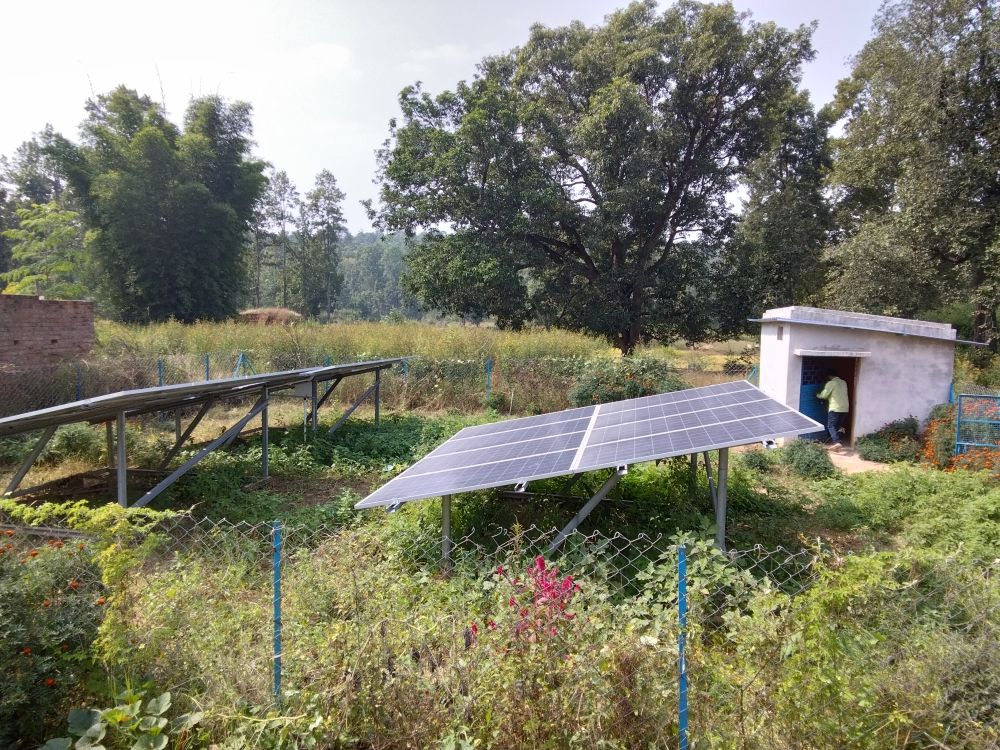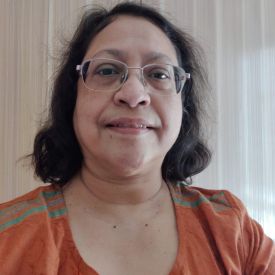Simdega district in Jharkhand – one of NITI Aayog’s ‘Aspirational Districts’ – comprises small habitations that are not yet connected to grid-based electricity. In this note, Goswami and co-authors discuss how the installation of a solar micro-grid in village Chinjheria created livelihood opportunities, while also making domestic lives easier and more productive. They outline the financial aspects of the initiative, highlighting the importance of developing sustainable business models.
Lalinder from the village of Chenjheria (in Simdega district, Jharkhand) had never seen any electricity in his house. With the exception of three standalone solar-operated streetlights, Lalinder’s village plunged into darkness after every sunset, while small solar battery-operated lights or kerosene lamps inadequately illuminated the homes.
Simdega falls under the purview of the ‘Aspirational District Programme’1 of the Government of India. The district comprises small and isolated habitations that are not yet connected to electricity supply from the main grid. Such habitations are considered as ‘virgin areas’ in the context of potential solar mini- and micro-grid projects (a micro-grid unit is one with a capacity of less than 10 kilowatt). From December 2022 onwards, with the installation of a solar micro-grid unit with the support of a philanthropic grant, the lives of the 36 households of Chinjheria underwent a magical transformation.

Picture credit: Authors' own
Powering up homes and workspaces
To Lalinder, assured electricity supply meant the possibility of realising dreams and aspirations. His mother and sisters now have more hours to do their work. Their day commences as early as 3 am when, with the help of electric lights, cooking and other domestic chores can be carried out. Life for the women has become easier with the use of electric appliances such as mixer blender and electric iron.
Post-harvest processing work like parboiling and de-husking rice starts in the early morning hours. By 8 am, the family is ready to go out to work in their agricultural fields – utilising the precious morning hours before it becomes too hot to work. Further, electricity is available to irrigate the fields in a cost-effective manner and crops other than the monsoon-dependent ones can be grown. It has also allowed Lalinder to use an electric saw while wood cutting, resulting in faster completion of the work and enhancing his productivity.
Finishing farm work before noon not only allows the entire family flexibility while planning the day’s schedule and completing other domestic chores, but also opens up the option of taking up other paid work. For instance, Lalinder now uses electric DJ sets at village functions and weddings, with electricity connection allowing him to move away from the use of his relatively expensive diesel-operated generator set.
The children in the house are able to study in the evening hours and can comfortably complete their homework requirements. The relentless heat of the summer days is offset with relief from using cooling fans. All of this has been possible due to the electricity provision from an 8 kilowatt solar micro-grid system in Chenjheria village. Electricity supply has been consistent with no voltage or lumen fluctuations, and not a single incident of outage for these households in the last one year. Even on days of heavy cloud cover, with the lack of sunshine restricting the charging of solar panels, the solar micro-grid can operate without outage for a week and meet thelighting needs of the village. This is possible due to the battery storage system, comprising of 60 batteries with a capacity of 2 volts each. A 120-volt storage capacity arranged in a series of five sets of power stacks ensures electricity supply during the night as well as on cloudy days. It is a fully automated system wherein inverters supply the electricity generated to the batteries that in turn feed the grid. When the battery storage reaches its capacity, the inverter auto-cuts and restarts the battery charging process as the storage reduces.
What it costs
In the case of Chenjheria village, the investment cost of the automated system works out to be around Rs. 60,000 per household. Households were required to pay Rs. 1,500 upfront to cover internal wiring, connections for four bulbs, two plug points, and electricity meter and miniature circuit breaker (MCB) system.

Picture credit: Authors' own
In addition, a security deposit of Rs. 1,500 is collected from each household by the Gram Samiti, which consists of representatives from the village households. The average monthly bill is in the range of Rs. 120-130, of which Rs. 100 is fixed cost and the remaining varies based on consumption at a rate of Rs. 10 per unit which ensured a connection of four charging points of lighting with a three-phase connection and an additional connection of a fan. If a household uses multiple gadgets for part-time businesses, the monthly bill can go up to Rs. 350. Most households who were connected to the micro-grid could afford to pay for it, and were willing to pay given the potential future benefits of the connection.
The revenues earned from the consumers through monthly electricity bills are used to meet the full operational, repair and maintenance costs of the micro-grid unit. The owner of the land where the project is situated is provided with free electricity, and in return, the cost of leasing is waived off.
Since these charges are subsidised, they do not reflect the actual cost of electricity provision. At present, the subsidy amounts to 75% of the investment and operational costs. On the one hand, an increase in costs can add upward pressure to the subsidy bill, while an enhanced ability and willingness among the households to pay more for access to the micro-grid can bring the subsidy down in the future. A self-sustained business model with blended finance complemented with public finance needs to be worked out in future to reduce the subsidy amount given to recover the investment and operational costs.
Moving towards a self-sustaining business model
To come out of subsidy-based electricity provision to rural households in the longer term, the paying capacity of households in the village needs to be upscaled. The solar micro-grid operations have led to the creation of agricultural and social enterprises, which may be leveraged in this regard. For instance, a co-benefit that has emerged in Chinjheria village is a cooperative structure of savings. The security deposit of Rs. 1,500 per household is used to build a corpus for meeting costs of any future repairs or replacement requirements. Thhis corpus ensures a community savings pool, which can thereafter also be used for household needs and can act as a risk hedging option – something which had previously been served solely by household savings. With a very low default rate amongst consumers, with most paying their monthly bills and security deposits, the savings accumulation has gone up. An ‘Urja Samiti’, comprising five female and four male representatives from households, chosen by the village representatives, manages the corpus and pays a nominal sum of Rs. 1,000 to the grid operator every month.
Preparing for the future
As highlighted in the case of Lalinder, solar energy has led to enterprise creation in the village. With an increase in use of electrical equipment, commercial load on the solar grid is expected to increase over time. Separate connections will need to be given to village households if individual households have to be provided with electricity to meet their commercial load. To meet these requirements, the community has suggested a modular expansion of the solar mini-grid or the installation of a new micro-grid going forward. Such installations can happen if larger philanthropic funds can be raised through community mobilisation, rural development and energy access programmes, and public private partnerships.

Picture credit: Authors' own
In the absence of grid-based electricity in rural homes, the importance of solar-based micro-grid is only going to increase in isolated villages like Chenjheria. Its sustained provision will depend on a suitable business model of energy financing, which imbibes the socioeconomic, development, governance and political contexts and how these is envisaged to evolve. This will be true in an interim stage of transition before grid-based, high-quality electricity reaches these households with backup systems complemented by modular capacities.
The case of Chenjheria highlights that philanthropic, grant-based financing models of solar micro-grids in India’s aspirational villages, supported by catalytic financing for scaling up micro-grid financing, can help in attaining the 500 gigawatt renewable energy generation goal of the country by 2030, while balancing and reaching the developmental targets by 2047.
All views expressed here are personal. The research conducted for this analysis has been possible due to the funding support received from HSBC by Ashoka Centre for People-Centric Energy Transition (ACPET) for the Financing Energy Transition Component of The HSBC Project.
The field visit has been possible due to the field coordination and facilitation support from TRIF.
Note:
- The Aspirational Districts Programme ranks districts on the basis of a composite index comprising of health, nutrition, education, basic infrastructure and poverty (NITI Aayog, 2018). This programme measures progress and targets areas where development is most needed.




 23 February, 2024
23 February, 2024 







Comments will be held for moderation. Your contact information will not be made public.